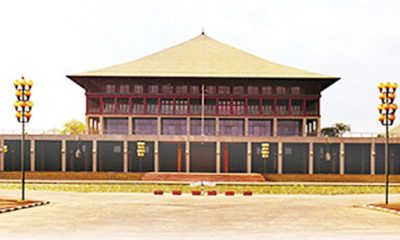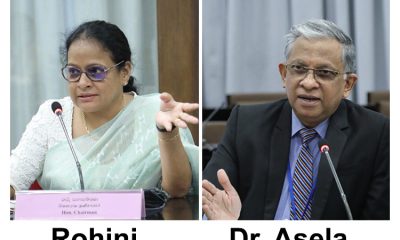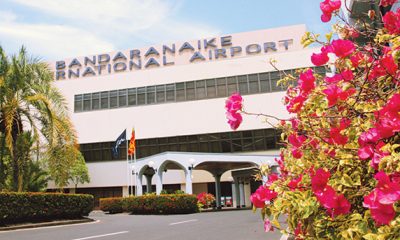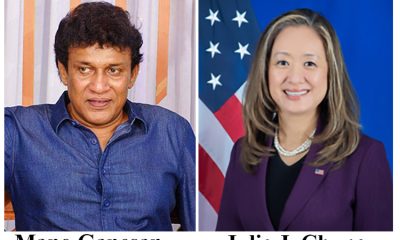Features
How to put Sri Lanka back to work
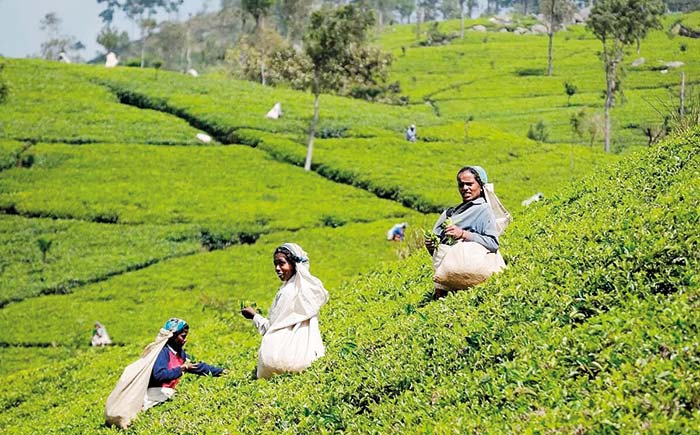
by Jayampathy Molligoda
Basic economic models followed by successive governments:
Since 1978, the successive governments have been following an aggressive open economic policy framework for Sri Lanka and there has been some progress in the much-needed infrastructure development compared to the period governed under a somewhat ‘closed economic system’. Basically, their open economic policy framework is founded on the following two basic economic models (i) ‘neo-classical’, monetarists policy prescription or (ii) ‘Post-Keynesian’ Economic school of thought which builds upon John Maynard Keynes’s argument that effective demand is the key determinant of economic performance.
The difference between these theories is that ‘ economics believe in controlling the supply of money that flows into the economy, while Keynesian economics involves government expenditures. In contrast to the neoclassical (mainstream) approach, Keynes argued that investment is not constrained by the availability of saving, but may be constrained by the availability of credit.
Monetarists believe that government spending causes inflation. The level of the money supply, which they feel has a direct impact on inflation, must be used to control it. In contrast, Keynesian economists believe that a troubled economy continues in a downward spiral unless an intervention drives consumers to buy more goods and services. Governments should balance out the cyclical movement of the economy by spending more in downturns and less in prosperous times (thereby preventing inflation).
One can argue, the open economic policy framework in Sri Lanka has not worked for the benefit of the majority of people although the governments from time to time used to follow either the ‘neo-classical’ principles or Keynesian Economic school of thought. The result is that the overall performance of the economy has been unsatisfactory. The economists are of the view that the economic downturn has been mainly due to serious structural weaknesses in the economy during a long period of time.
Sri Lanka’s relative export performance, especially during the last ten- year period has drastically declined and thus widening the trade deficit around US $ 8- 10 billion per annum. It is clear that the poor export performance relative to increased import bill, together with the external ‘current account’ deficit and large fiscal deficits in the government budgets, popularly known as the ‘twin deficits’, have been identified as the key structural weaknesses that have affected the economy for several decades with continuing adverse trends into the future. The positive feature is the export of goods during the last three years (2021,2022 and 2023) recorded a notable increase and surpassed US $ 13 billion since 2022, however, trade deficit remains a major concern due to the heavy import bill.
The government which came in to power in 2020 was not keen to have an IMF programme as they were of the opinion that such action (i) will definitely contract economic growth, (ii) imposing high taxes and high bank interest rates will reduce business activities, (iii) having a widely fluctuating rupee puts enormous burden on the people with high imported inflation and unbearable cost of living impact and (iv) many other adverse consequences. In short, their view was that people’s purchasing power will be badly affected. From the present socio/economic situation faced by the majority of people, it can be seen that there is some truth of what they had predicted if they had adopted the IMF policy prescription.
Pros and cons of the major policy shift since April 2022:
President GR during the latter part of his tenure was reluctantly compelled to adopt a slightly different economic strategy (i) received a positive response from IMF (in March ’22) to his letter requesting EF (Extended Fund) facility (ii) allowed the rupee to fluctuate, initially a ‘managed float’ mechanism as decided by CB on March 7, 2022 (iii) dissolved the cabinet during the first week of April ‘22 and appointed a new economic team (iv) the Treasury secretary in consultation with the Governor, CB and the new Finance Minister had announced one of the most controversial decisions, i.e. ‘pre emptive’ debt default on April 12, ‘22. Since then, the CB used the term ‘debt standstill’ instead of default (Page 187 of the CB Annual Report-2022)
Upon resignation of President GR in July ’22 then Prime minister RW was elected as President through a ‘parliamentary majority vote’ in accordance with the constitutional provisions for the remaining period of GR’s tenure which ends in October 2024. Since then, the CB Governor and his team have been advising the government on the macro- economic policies, especially the monetary policy area based on IMF programme.
The CBSL has adopted a strategy of curbing inflation as a high priority by increasing the interest rate, imposing high taxation and further tightening monetary policy. President RW and his economic team have been able to manage to stabilize the macro economy to a certain extent thus eliminating the acute shortages in the market place, including petroleum products, gas etc. and also tackled the power cuts imposed by CEB during that time.
However, this was achieved at the expense of unbearable burden on households due to high cost of living, job losses and closure of a number of SME businesses, micro enterprises etc. The annual report of the Institute of Policy studies (IPS) – 2022 stated that only remedy on hand was to curb inflation through a forced ‘economic recession’.
The Monetary board of CBSL on March 7, ’22 decided to move away from the fixed exchange rate that prevailed since September 2021, it was announced that they expect an upper limit of Rs.230/-. Nevertheless, from March 8 or 9 onwards, the rupee was allowed to be floated based on market sentiments until May 12, ‘22 and by that time, the exchange rate of Rs.230 has gone up to Rs 377/- per US $. That’s the period, where inflation skyrocketed due to supply side ‘cost push’ imported inflation, more than the ‘demand pull’ inflation. On May 12, CB had to rectify this market behaviour (undue volatility) by shifting its policy to a ‘managed float’ with the introduction of middle rate to facilitate orderly behaviour of the FOREX market.
So far, Sri Lanka has received a total disbursement of two tranches amounting to US$ 670 million out of the US$ 3 billion Extended Fund Facility (EFF) approved by the IMF. The government of the day has been managing the ‘day- today’ inflows/outflows in the ‘forex account’ satisfactorily and, also managed to improve the government revenue collection through higher taxes imposed on the people. The private players who operate businesses especially the exporters and other foreign exchange earners have been able to build up some confidence on the government policy environment and started remitting their ‘forex income’ to the country through established banking systems. The Tourism sector is performing relatively well and ‘forex’ income to the country continues to flow in, thus relieving some burden on the people.
On the negative side, there is an undue delay in the negotiation process of the ‘debt restructuring’ with foreign creditors. (Debt to GDP ratio remains a major concern) Most of the sub sectors of the economy i.e. the so called ‘production economy’ both in the agriculture and manufacturing sub-sectors are not performing well. Although, the government tax revenue has increased significantly, the budget deficit in nominal terms has not made any progress showing reductions.
According to recent surveys conducted by independent research teams, majority of the people – five million households, SMEs, micro enterprises – are really suffering due to high cost of living, higher unemployment rate, further job losses, lack of purchasing power as well as deteriorating health care and educational sectors. The real issue has been that our country’s economic growth has been ‘negative’ during the last five consecutive quarters since 2021.
Solution lies in putting Sri Lanka back to work:
As indicated in my previous published articles, the government must focus on economic (GDP) growth– meaning real economics not financial numbers (transfer payments) etc only. In simple terms, the fundamental solution lies in making one thing to happen;
GDP growth = C+I+ G+ (exports-imports), where, C- consumption and I- investment, G- government spending.
We don’t have to reinvent the wheel. During the great depression period in 1930’s, the US/western economies were able to overcome the crisis successfully by practicing the ‘school of thought’ recommended by John Maynard Keynes, not necessarily based on neo-classical economic principles. Since then, many governments have been adopting the same principles and eminent economists of the calibre Professor Joseph E Stiglitz, winner of Nobel Prize /former Chief Economist of World Bank, Thomas Piketty, French economist who wrote the landmark analysis of Western economic inequality, “Capital in the 21st Century” and others have further developed the Keynesian model.
These economists urge governments to embrace real solutions: investing in education, science, technology and infrastructure, offering more help to the children of the poor, doing more to restore the economy to full employment etc. It is interesting to note that even the IMF, an organisation not taking radical positions, has taken up the position that inequality is associated with instability. (‘Inequality and unsustainable growth; two sides of the same coin?’ – IMF staff discussion note- 2011)
According to Stiglitz, monetary policy instruments for managing the macro economy have proved ineffective. Here are some home truths:
(i) The single most important thing is how to put the country back to work.
(ii) The country should be focussed on job creation. We can’t raise economic growth, create jobs by cutting spending and firing workers. The reason that businesses with access to capital are not investing/hiring people is that there is insufficient demand for their products. Weakening demand in the market place only discourages investment and hiring people.
(iii) The advantage of having underinvestment in the public and private sector for so long (nearly 10 years) is that we have many high return opportunities. Use this opportunity with low ‘long term’ bank interest rates to focus high return, labour intensive- investments in infrastructure, education, health care, technology etc.
(iv) Increased output can generate higher tax revenue to the treasury to pay low interest on the debt. Higher income to people means higher tax revenue to treasury without unnecessarily increasing the VAT rate to 18% and other tax rates.
(v) Government can change the design of the tax system and expenditure pattern. Increasing taxes at the top five percent and lowering taxes at the middle class. This will lead to more consumption spending, which is not happening now- in other words create demand in the market place.
(vi) Review Indirect taxes: Direct taxes ratio. The revenue from Indirect taxes such as VAT compared to Direct taxes (income taxes) is disproportionately very high, thus creating inequality in the society and negating the cardinal principle of progressive tax system.
(vii) Sri Lanka’s debt burden will reduce and economic growth increases, meaning debt to GDP ratio will improve.
It is simply a matter of politics:
Presidential elections are due to be held in early October ’24 and it appears that the two main opposition parties tend to gain popularity among the people, who are eligible to vote, especially the NPP and SJB. The present government and the two main opposition parties are in possession of somewhat comprehensive policy packages. However, whether they could offer a viable economic model at the elections as against the two economic models practiced by successive governments is yet to be seen. My own view is the success depends on how to put Sri Lanka back to work.
Features
The heart-friendly health minister

by Dr Gotabhya Ranasinghe
Senior Consultant Cardiologist
National Hospital Sri Lanka
When we sought a meeting with Hon Dr. Ramesh Pathirana, Minister of Health, he graciously cleared his busy schedule to accommodate us. Renowned for his attentive listening and deep understanding, Minister Pathirana is dedicated to advancing the health sector. His openness and transparency exemplify the qualities of an exemplary politician and minister.
Dr. Palitha Mahipala, the current Health Secretary, demonstrates both commendable enthusiasm and unwavering support. This combination of attributes makes him a highly compatible colleague for the esteemed Minister of Health.
Our discussion centered on a project that has been in the works for the past 30 years, one that no other minister had managed to advance.
Minister Pathirana, however, recognized the project’s significance and its potential to revolutionize care for heart patients.
The project involves the construction of a state-of-the-art facility at the premises of the National Hospital Colombo. The project’s location within the premises of the National Hospital underscores its importance and relevance to the healthcare infrastructure of the nation.
This facility will include a cardiology building and a tertiary care center, equipped with the latest technology to handle and treat all types of heart-related conditions and surgeries.
Securing funding was a major milestone for this initiative. Minister Pathirana successfully obtained approval for a $40 billion loan from the Asian Development Bank. With the funding in place, the foundation stone is scheduled to be laid in September this year, and construction will begin in January 2025.
This project guarantees a consistent and uninterrupted supply of stents and related medications for heart patients. As a result, patients will have timely access to essential medical supplies during their treatment and recovery. By securing these critical resources, the project aims to enhance patient outcomes, minimize treatment delays, and maintain the highest standards of cardiac care.
Upon its fruition, this monumental building will serve as a beacon of hope and healing, symbolizing the unwavering dedication to improving patient outcomes and fostering a healthier society.We anticipate a future marked by significant progress and positive outcomes in Sri Lanka’s cardiovascular treatment landscape within the foreseeable timeframe.
Features
A LOVING TRIBUTE TO JESUIT FR. ALOYSIUS PIERIS ON HIS 90th BIRTHDAY

by Fr. Emmanuel Fernando, OMI
Jesuit Fr. Aloysius Pieris (affectionately called Fr. Aloy) celebrated his 90th birthday on April 9, 2024 and I, as the editor of our Oblate Journal, THE MISSIONARY OBLATE had gone to press by that time. Immediately I decided to publish an article, appreciating the untiring selfless services he continues to offer for inter-Faith dialogue, the renewal of the Catholic Church, his concern for the poor and the suffering Sri Lankan masses and to me, the present writer.
It was in 1988, when I was appointed Director of the Oblate Scholastics at Ampitiya by the then Oblate Provincial Fr. Anselm Silva, that I came to know Fr. Aloy more closely. Knowing well his expertise in matters spiritual, theological, Indological and pastoral, and with the collaborative spirit of my companion-formators, our Oblate Scholastics were sent to Tulana, the Research and Encounter Centre, Kelaniya, of which he is the Founder-Director, for ‘exposure-programmes’ on matters spiritual, biblical, theological and pastoral. Some of these dimensions according to my view and that of my companion-formators, were not available at the National Seminary, Ampitiya.
Ever since that time, our Oblate formators/ accompaniers at the Oblate Scholasticate, Ampitiya , have continued to send our Oblate Scholastics to Tulana Centre for deepening their insights and convictions regarding matters needed to serve the people in today’s context. Fr. Aloy also had tried very enthusiastically with the Oblate team headed by Frs. Oswald Firth and Clement Waidyasekara to begin a Theologate, directed by the Religious Congregations in Sri Lanka, for the contextual formation/ accompaniment of their members. It should very well be a desired goal of the Leaders / Provincials of the Religious Congregations.
Besides being a formator/accompanier at the Oblate Scholasticate, I was entrusted also with the task of editing and publishing our Oblate journal, ‘The Missionary Oblate’. To maintain the quality of the journal I continue to depend on Fr. Aloy for his thought-provoking and stimulating articles on Biblical Spirituality, Biblical Theology and Ecclesiology. I am very grateful to him for his generous assistance. Of late, his writings on renewal of the Church, initiated by Pope St. John XX111 and continued by Pope Francis through the Synodal path, published in our Oblate journal, enable our readers to focus their attention also on the needed renewal in the Catholic Church in Sri Lanka. Fr. Aloy appreciated very much the Synodal path adopted by the Jesuit Pope Francis for the renewal of the Church, rooted very much on prayerful discernment. In my Religious and presbyteral life, Fr.Aloy continues to be my spiritual animator / guide and ongoing formator / acccompanier.
Fr. Aloysius Pieris, BA Hons (Lond), LPh (SHC, India), STL (PFT, Naples), PhD (SLU/VC), ThD (Tilburg), D.Ltt (KU), has been one of the eminent Asian theologians well recognized internationally and one who has lectured and held visiting chairs in many universities both in the West and in the East. Many members of Religious Congregations from Asian countries have benefited from his lectures and guidance in the East Asian Pastoral Institute (EAPI) in Manila, Philippines. He had been a Theologian consulted by the Federation of Asian Bishops’ Conferences for many years. During his professorship at the Gregorian University in Rome, he was called to be a member of a special group of advisers on other religions consulted by Pope Paul VI.
Fr. Aloy is the author of more than 30 books and well over 500 Research Papers. Some of his books and articles have been translated and published in several countries. Among those books, one can find the following: 1) The Genesis of an Asian Theology of Liberation (An Autobiographical Excursus on the Art of Theologising in Asia, 2) An Asian Theology of Liberation, 3) Providential Timeliness of Vatican 11 (a long-overdue halt to a scandalous millennium, 4) Give Vatican 11 a chance, 5) Leadership in the Church, 6) Relishing our faith in working for justice (Themes for study and discussion), 7) A Message meant mainly, not exclusively for Jesuits (Background information necessary for helping Francis renew the Church), 8) Lent in Lanka (Reflections and Resolutions, 9) Love meets wisdom (A Christian Experience of Buddhism, 10) Fire and Water 11) God’s Reign for God’s poor, 12) Our Unhiddden Agenda (How we Jesuits work, pray and form our men). He is also the Editor of two journals, Vagdevi, Journal of Religious Reflection and Dialogue, New Series.
Fr. Aloy has a BA in Pali and Sanskrit from the University of London and a Ph.D in Buddhist Philosophy from the University of Sri Lankan, Vidyodaya Campus. On Nov. 23, 2019, he was awarded the prestigious honorary Doctorate of Literature (D.Litt) by the Chancellor of the University of Kelaniya, the Most Venerable Welamitiyawe Dharmakirthi Sri Kusala Dhamma Thera.
Fr. Aloy continues to be a promoter of Gospel values and virtues. Justice as a constitutive dimension of love and social concern for the downtrodden masses are very much noted in his life and work. He had very much appreciated the commitment of the late Fr. Joseph (Joe) Fernando, the National Director of the Social and Economic Centre (SEDEC) for the poor.
In Sri Lanka, a few religious Congregations – the Good Shepherd Sisters, the Christian Brothers, the Marist Brothers and the Oblates – have invited him to animate their members especially during their Provincial Congresses, Chapters and International Conferences. The mainline Christian Churches also have sought his advice and followed his seminars. I, for one, regret very much, that the Sri Lankan authorities of the Catholic Church –today’s Hierarchy—- have not sought Fr.
Aloy’s expertise for the renewal of the Catholic Church in Sri Lanka and thus have not benefited from the immense store of wisdom and insight that he can offer to our local Church while the Sri Lankan bishops who governed the Catholic church in the immediate aftermath of the Second Vatican Council (Edmund Fernando OMI, Anthony de Saram, Leo Nanayakkara OSB, Frank Marcus Fernando, Paul Perera,) visited him and consulted him on many matters. Among the Tamil Bishops, Bishop Rayappu Joseph was keeping close contact with him and Bishop J. Deogupillai hosted him and his team visiting him after the horrible Black July massacre of Tamils.
Features
A fairy tale, success or debacle

Sri Lanka-Singapore Free Trade Agreement
By Gomi Senadhira
senadhiragomi@gmail.com
“You might tell fairy tales, but the progress of a country cannot be achieved through such narratives. A country cannot be developed by making false promises. The country moved backward because of the electoral promises made by political parties throughout time. We have witnessed that the ultimate result of this is the country becoming bankrupt. Unfortunately, many segments of the population have not come to realize this yet.” – President Ranil Wickremesinghe, 2024 Budget speech
Any Sri Lankan would agree with the above words of President Wickremesinghe on the false promises our politicians and officials make and the fairy tales they narrate which bankrupted this country. So, to understand this, let’s look at one such fairy tale with lots of false promises; Ranil Wickremesinghe’s greatest achievement in the area of international trade and investment promotion during the Yahapalana period, Sri Lanka-Singapore Free Trade Agreement (SLSFTA).
It is appropriate and timely to do it now as Finance Minister Wickremesinghe has just presented to parliament a bill on the National Policy on Economic Transformation which includes the establishment of an Office for International Trade and the Sri Lanka Institute of Economics and International Trade.
Was SLSFTA a “Cleverly negotiated Free Trade Agreement” as stated by the (former) Minister of Development Strategies and International Trade Malik Samarawickrama during the Parliamentary Debate on the SLSFTA in July 2018, or a colossal blunder covered up with lies, false promises, and fairy tales? After SLSFTA was signed there were a number of fairy tales published on this agreement by the Ministry of Development Strategies and International, Institute of Policy Studies, and others.
However, for this article, I would like to limit my comments to the speech by Minister Samarawickrama during the Parliamentary Debate, and the two most important areas in the agreement which were covered up with lies, fairy tales, and false promises, namely: revenue loss for Sri Lanka and Investment from Singapore. On the other important area, “Waste products dumping” I do not want to comment here as I have written extensively on the issue.
1. The revenue loss
During the Parliamentary Debate in July 2018, Minister Samarawickrama stated “…. let me reiterate that this FTA with Singapore has been very cleverly negotiated by us…. The liberalisation programme under this FTA has been carefully designed to have the least impact on domestic industry and revenue collection. We have included all revenue sensitive items in the negative list of items which will not be subject to removal of tariff. Therefore, 97.8% revenue from Customs duty is protected. Our tariff liberalisation will take place over a period of 12-15 years! In fact, the revenue earned through tariffs on goods imported from Singapore last year was Rs. 35 billion.
The revenue loss for over the next 15 years due to the FTA is only Rs. 733 million– which when annualised, on average, is just Rs. 51 million. That is just 0.14% per year! So anyone who claims the Singapore FTA causes revenue loss to the Government cannot do basic arithmetic! Mr. Speaker, in conclusion, I call on my fellow members of this House – don’t mislead the public with baseless criticism that is not grounded in facts. Don’t look at petty politics and use these issues for your own political survival.”
I was surprised to read the minister’s speech because an article published in January 2018 in “The Straits Times“, based on information released by the Singaporean Negotiators stated, “…. With the FTA, tariff savings for Singapore exports are estimated to hit $10 million annually“.
As the annual tariff savings (that is the revenue loss for Sri Lanka) calculated by the Singaporean Negotiators, Singaporean $ 10 million (Sri Lankan rupees 1,200 million in 2018) was way above the rupees’ 733 million revenue loss for 15 years estimated by the Sri Lankan negotiators, it was clear to any observer that one of the parties to the agreement had not done the basic arithmetic!
Six years later, according to a report published by “The Morning” newspaper, speaking at the Committee on Public Finance (COPF) on 7th May 2024, Mr Samarawickrama’s chief trade negotiator K.J. Weerasinghehad had admitted “…. that forecasted revenue loss for the Government of Sri Lanka through the Singapore FTA is Rs. 450 million in 2023 and Rs. 1.3 billion in 2024.”
If these numbers are correct, as tariff liberalisation under the SLSFTA has just started, we will pass Rs 2 billion very soon. Then, the question is how Sri Lanka’s trade negotiators made such a colossal blunder. Didn’t they do their basic arithmetic? If they didn’t know how to do basic arithmetic they should have at least done their basic readings. For example, the headline of the article published in The Straits Times in January 2018 was “Singapore, Sri Lanka sign FTA, annual savings of $10m expected”.
Anyway, as Sri Lanka’s chief negotiator reiterated at the COPF meeting that “…. since 99% of the tariffs in Singapore have zero rates of duty, Sri Lanka has agreed on 80% tariff liberalisation over a period of 15 years while expecting Singapore investments to address the imbalance in trade,” let’s turn towards investment.
Investment from Singapore
In July 2018, speaking during the Parliamentary Debate on the FTA this is what Minister Malik Samarawickrama stated on investment from Singapore, “Already, thanks to this FTA, in just the past two-and-a-half months since the agreement came into effect we have received a proposal from Singapore for investment amounting to $ 14.8 billion in an oil refinery for export of petroleum products. In addition, we have proposals for a steel manufacturing plant for exports ($ 1 billion investment), flour milling plant ($ 50 million), sugar refinery ($ 200 million). This adds up to more than $ 16.05 billion in the pipeline on these projects alone.
And all of these projects will create thousands of more jobs for our people. In principle approval has already been granted by the BOI and the investors are awaiting the release of land the environmental approvals to commence the project.
I request the Opposition and those with vested interests to change their narrow-minded thinking and join us to develop our country. We must always look at what is best for the whole community, not just the few who may oppose. We owe it to our people to courageously take decisions that will change their lives for the better.”
According to the media report I quoted earlier, speaking at the Committee on Public Finance (COPF) Chief Negotiator Weerasinghe has admitted that Sri Lanka was not happy with overall Singapore investments that have come in the past few years in return for the trade liberalisation under the Singapore-Sri Lanka Free Trade Agreement. He has added that between 2021 and 2023 the total investment from Singapore had been around $162 million!
What happened to those projects worth $16 billion negotiated, thanks to the SLSFTA, in just the two-and-a-half months after the agreement came into effect and approved by the BOI? I do not know about the steel manufacturing plant for exports ($ 1 billion investment), flour milling plant ($ 50 million) and sugar refinery ($ 200 million).
However, story of the multibillion-dollar investment in the Petroleum Refinery unfolded in a manner that would qualify it as the best fairy tale with false promises presented by our politicians and the officials, prior to 2019 elections.
Though many Sri Lankans got to know, through the media which repeatedly highlighted a plethora of issues surrounding the project and the questionable credentials of the Singaporean investor, the construction work on the Mirrijiwela Oil Refinery along with the cement factory began on the24th of March 2019 with a bang and Minister Ranil Wickremesinghe and his ministers along with the foreign and local dignitaries laid the foundation stones.
That was few months before the 2019 Presidential elections. Inaugurating the construction work Prime Minister Ranil Wickremesinghe said the projects will create thousands of job opportunities in the area and surrounding districts.
The oil refinery, which was to be built over 200 acres of land, with the capacity to refine 200,000 barrels of crude oil per day, was to generate US$7 billion of exports and create 1,500 direct and 3,000 indirect jobs. The construction of the refinery was to be completed in 44 months. Four years later, in August 2023 the Cabinet of Ministers approved the proposal presented by President Ranil Wickremesinghe to cancel the agreement with the investors of the refinery as the project has not been implemented! Can they explain to the country how much money was wasted to produce that fairy tale?
It is obvious that the President, ministers, and officials had made huge blunders and had deliberately misled the public and the parliament on the revenue loss and potential investment from SLSFTA with fairy tales and false promises.
As the president himself said, a country cannot be developed by making false promises or with fairy tales and these false promises and fairy tales had bankrupted the country. “Unfortunately, many segments of the population have not come to realize this yet”.
(The writer, a specialist and an activist on trade and development issues . )


